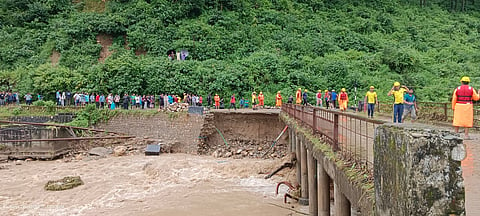

Figures in this article have been revised to include the latest information.
13 people dead and 16 missing after heavy rains on September 15–16
Sahasradhara received 264 mm rainfall in 24 hours; “extremely heavy rain” recorded in one-hour spell
Experts say Doon Valley’s fragile geology magnifies the damage of intense rainfall
SDRF rescues 200 students in Paundha and three people from Chandrabhaga river in Rishikesh
Heavy rains in Uttarakhand on September 15–16, 2025 left 13 people dead in the state capital, Dehradun, with three injured and 16 reported missing. One fatality was also confirmed in Nainital.
A press release from the Dehradun District Information Department, issued late on September 16, said extensive damage had been reported across the district, with losses including 13 bridges, 10 culverts, two houses, 31 boundary walls, two Amrit Sarovars, 12 farms, 12 canals, 21 roads, seven drinking water schemes, eight hoses and 24 bridges across various development blocks.
According to the India Meteorological Department’s regional centre in Dehradun, Sahasradhara recorded 264 millimetres (mm) of rainfall in 24 hours up to 8.30 am, placing it in the “very heavy” category. The threshold for a cloudburst is more than 100 mm in an hour, which was not reached. However, Sahasradhara received 54 mm of rain between 5.15 am and 6.15 am — classed as “extremely heavy rain” — following 49 mm in the preceding hour.
Other areas in Dehradun district also recorded significant rainfall: Kalsi registered 119 mm in 24 hours, including 67 mm in a single hour late on Monday night, while Maldevta recorded 149 mm. Elsewhere, Nainital received 105 mm, Jolly Grant 93 mm, Hathibarkala 89.5 mm, Thal 80 mm, Bhimtal 75.5 mm, Rani Chauri 71.5 mm, Pokhari 69.5 mm, Karnaprayag 53.5 mm and Chaukhutia 52.5 mm.
“This is not unusual rain. Dehradun has received very heavy rainfall in the past,” said Chander Singh Tomar, incharge for the Dehradun centre. “The highest rainfall was in July 1966, when 487 mm was recorded in 24 hours.”
He noted that while Sahasradhara had seen two consecutive hours of extreme rainfall, damage depends largely on geography.
Geologist SP Sati said the worst-affected parts of Dehradun lie in the southern slopes of the Mussoorie range. “Narendra Nagar receives the highest rainfall in Uttarakhand and is often called the Cherrapunji of Uttarakhand,” he said. The Mussoorie and Kunjapuri ranges, along with Nainital and Lansdowne, force monsoon clouds to shed rainfall on their southern slopes.
“These rains have historically shaped the Doon Valley and the Bhabar plains (Kotdwar, Haldwani, Ramnagar and Rishikesh) through erosion and deposition of debris,” he explained. “The Doon Valley itself is formed from such debris. While the phenomenon is natural, the frequency of extreme rainfall has increased in recent years.”
He contrasted past events with the present, pointing out that in 1966 the same levels of flooding would have caused little damage because of lower population density. “Earlier, seasonal rivers like the Rispana, Bindal, Song and Malan flowed freely. No matter how high the flow, they never breached their banks. Dehradun’s drainage system was robust, with canals and no encroachment. Flooding is a natural process; houses being washed away is man-made.”
The downpour left around 200 students stranded at a vocational institute in Paundha, Dehradun, due to waterlogging. They were rescued safely by the State Disaster Response Force (SDRF). In Rishikesh, three people trapped in the swollen Chandrabhaga river were also rescued by the Fire Service and SDRF.